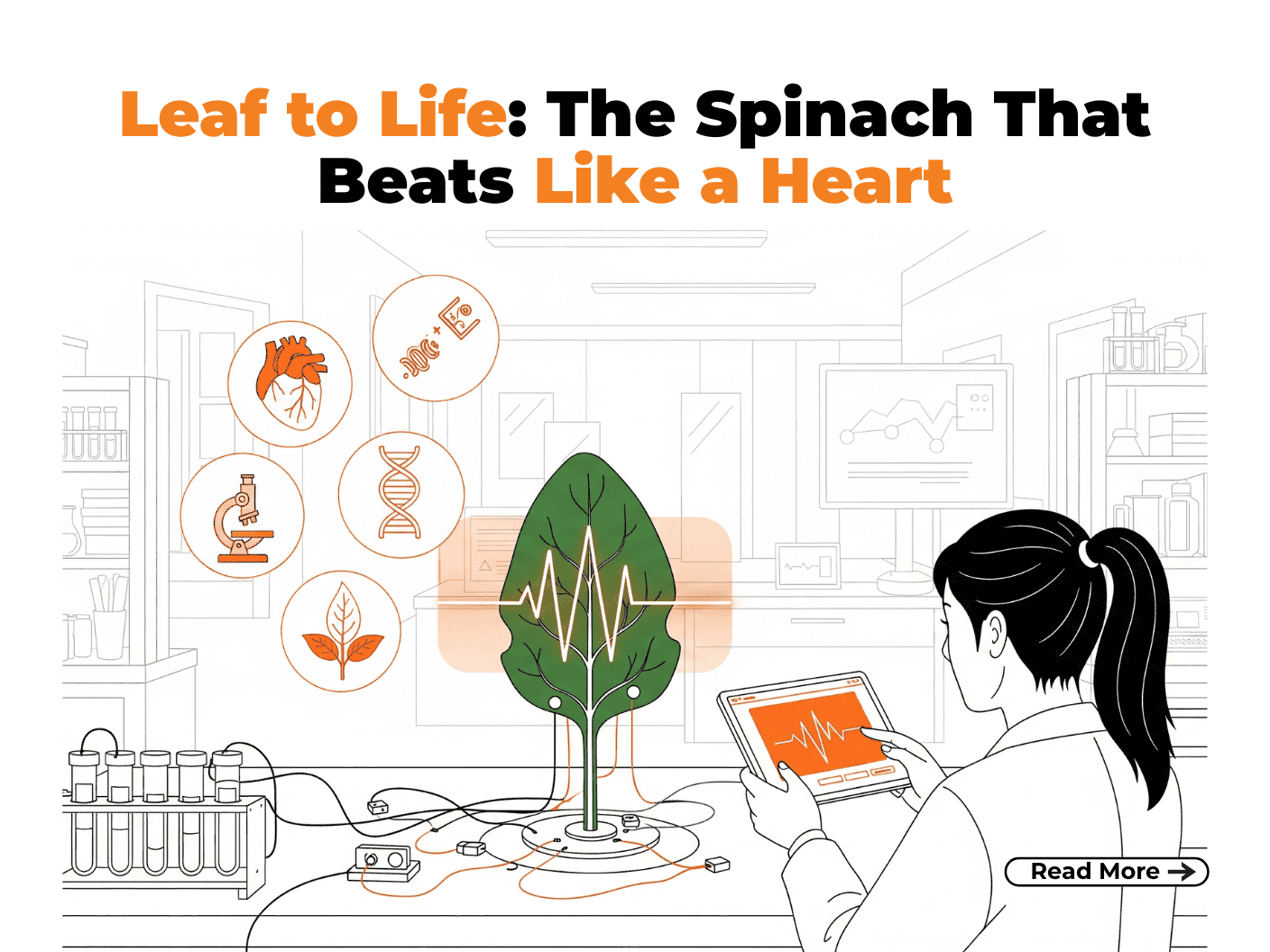 What if the next breakthrough in saving a human life came… from your salad bowl?
What if the next breakthrough in saving a human life came… from your salad bowl?
Yes, you read that right.
But this isn’t fiction. This is real, mind-blowing science—where the boundary between plants and people is being reimagined by researchers, one leaf at a time.
In a world where we’re used to technology looking like sleek gadgets and glowing screens, this quiet little experiment reminds us that nature, in all its leafy simplicity, might just hold the answers we’ve been seeking all along.
So… Why Spinach?
That was the question on many people’s minds when, a few years ago, a team of scientists from Worcester Polytechnic Institute (WPI) published a study showing that spinach leaves could be turned into working heart tissue. Yes, actual beating tissue.
It started with a common but critical problem in the world of tissue engineering: how do you recreate tiny blood vessels—capillaries—that are so essential to keeping tissues alive?
Without those microscopic highways delivering oxygen and nutrients, even the most promising lab-grown tissue will fail. And building those complex networks from scratch? Incredibly difficult.
Now here’s the genius part. Spinach leaves naturally have a complex network of veins. They’re thin, delicate, and branch out in a way eerily similar to human capillaries. Nature already built what scientists had been trying to design for years.
That’s when the lightbulb moment happened: What if we could use the spinach’s existing structure as a scaffold to grow human tissue?
From Salad to Science
The process started with something called decellularization. It’s like giving the spinach a gentle detox bath—washing away its plant cells using a soap-like solution until all that remains is a transparent, ghost-like frame made of cellulose (a natural fiber).
This “leaf skeleton” is more than just a pretty structure. Cellulose is biocompatible, meaning human cells can grow on it without getting rejected. Bioengineered heart tissue built on leafy greens is redefining the possibilities in regenerative medicine.
So, researchers took this decellularized spinach and began injecting human heart cells into it. They weren’t sure what to expect—but what happened next was extraordinary.
The human cells attached. They grew. And then, almost like something out of a magic trick—they began to beat.
Spinach leaf as vascular network for heart tissue allows for efficient blood and oxygen flow, critical to tissue survival. Yes. That spinach leaf, now filled with human heart muscle cells, actually started to pulse in rhythm. It wasn’t just alive—it was working.
From Weird to Wonderful
The news went viral, and for good reason. It’s not every day that someone turns a leafy green into a mini beating heart.
But beyond the “wow” factor, this work holds real medical potential. Imagine using plant structures to grow living tissues for patients with heart damage. Think about skin grafts, bone repairs, or even new organs—all built on a base of something as humble as a vegetable.
Here’s why this approach could be a game-changer:
- It’s sustainable. Plants like spinach are cheap, widely available, and renewable.
- It’s ethical. No animal tissue or synthetic scaffolds are needed.
- It’s scalable. Imagine greenhouses not just growing food—but raw materials for future transplants.
But… Why Not Kale? Why only Spinach?
Great question! While spinach stole the spotlight for this particular breakthrough, it’s not the only plant being explored. Bioengineering with plants isn’t a trend—it’s a technological frontier marrying botany and medicine.
Each plant has a unique vascular layout:
- Parsley offers bushy, three-dimensional vein networks.
- Sweet potatoes and peanuts may be suitable for denser tissues like bone or cartilage.
- Even lotus leaves and woody stems are being examined for their structural properties.
In other words, the entire plant kingdom is becoming a bioengineering playground.
A New and Greener Chapter in Regenerative Medicine
This leafy innovation is part of a larger movement called biomimicry—learning from nature to solve human problems.
Instead of reinventing the wheel (or the blood vessel), scientists are asking: What has nature already perfected—and how can we use that?
And this isn’t just about curiosity. There’s urgency here too.
Every year, thousands of people die waiting for organ transplants. Even for those who get them, the challenges of rejection, scarcity, and lifelong medication are enormous.
What if we could grow personalized tissues using a patient’s own cells—on a plant-based scaffold? Suddenly, the spinach leaf doesn’t just represent a meal… It represents hope.
What Happens Next?
While we’re not quite ready to grow full-sized hearts in the garden, researchers are moving steadily forward. The spinach experiment was a proof of concept, and now it’s opening doors to more advanced techniques—combining plant scaffolds with 3D bioprinting, stem cell therapy, and even organ-on-a-chip technologies.
The dream? A future where we can grow living tissues in the lab, using a blend of biology, botany, and bold ideas.
And in the process, we redefine not just how we treat disease, but how we see life itself.
Let’s Pause for a Moment…
Let’s just sit with the beauty of this: A green leaf, once rooted in soil, now pulses with human life in a lab.
It’s poetic. It’s improbable. And it’s exactly the kind of story we need today.
Because in a world that often feels divided, anxious, and overwhelmed, stories like this remind us what’s possible when creativity meets science—when we stop seeing things in isolation, and instead see the connections between all forms of life.
That spinach leaf wasn’t just a plant. It was a blueprint waiting to be noticed. A reminder that sometimes, the answers we seek in high-tech labs might be quietly photosynthesizing on our plates.
A Leaf with a Heart: The Weird, the Wild, and the Worthwhile
So, the next time you look at your salad, consider this: hidden in those leaves is a pattern—an intricate, beautiful map—that scientists are learning to decode and repurpose for healing human hearts.
This story isn’t just about spinach. It’s about imagination. About refusing to accept limits. About finding life where no one thought to look.
Because when you really think about it, what could be more human than turning a leaf into love, into life, into hope?














